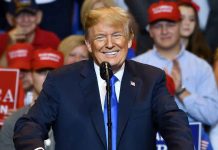
Kevin Hassett’s return to the Trump administration signals potentially transformative shifts in handling the national debt and tax policies.
Key Takeaways
- Trump’s fiscal reforms target trade, energy, regulations, and tax spending cuts.
- Hassett argues corporate tax cuts benefit workers, countering common perceptions.
- The U.S. faces over $36 trillion in debt amid ongoing inflation challenges.
- Trump’s strategy includes using tariffs for negotiation as shown in Colombian talks.
- Hassett emphasizes spending cuts over tax hikes for effective debt reduction.
Strategic Fiscal Reforms
President Trump’s economic strategy heavily focuses on comprehensive fiscal reforms. Key areas include trade, energy, regulations, and significant tax and spending cuts. These reforms, led by the National Economic Council director Kevin Hassett, are predicted to usher in a “golden age” of economic progress by implementing unprecedented supply-side measures.
Hassett believes reducing the corporate tax rate from 21% to 15% could significantly boost worker wages. These measures aim for long-term economic stability and growth. Despite the challenges, Hassett argues that pursuing domestic energy production is a cornerstone for controlling inflation.
Congrats, Kevin Hassett!
I hope you’ll work to reject more government spending and protectionism.
More ideas here: https://t.co/FsqVAmHug1. https://t.co/csvfaIkX7P
— Vance Ginn (@VanceGinn) November 27, 2024
Inflation and Debt Management
Under President Trump’s renewed vision, the focus is on managing the national debt, which has exceeded $36 trillion. Hassett’s research underscores the importance of focusing on spending cuts over tax increases for effective fiscal consolidation. His research suggests that spending cuts, not taxation, are more effective in balancing budgets.
The previous fiscal strategy’s reliance on tax increases proved less effective compared to models emphasizing spending cuts. Successful fiscal interventions historically emphasized around 85% spending reductions to achieve sustainable economic outcomes.
The Impact of Tariffs
Kevin Hassett outlines Trump’s economic agenda with tariffs as part of a broader strategy to ensure policy concessions favoring American interests. The use of tariffs, as demonstrated in negotiations with Colombia, aligns with Trump’s commitment to putting America first in global trade discussions. This approach not only seeks immediate economic reform but also positions the U.S. strategically in the global market.
“I think that you saw from the Colombia negotiation that the president is going to use tariffs if he needs to, in order to get people to make policy concessions that are good for America, that put America first,” said Hassett.
As the administration navigates significant economic challenges, Hassett’s influence on policy indicates a possible shift toward more disciplined financial management. This focuses on sustainable growth, job creation, and stringent fiscal responsibility, moving away from ephemeral populist strategies.





